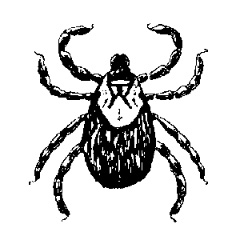Tick season in the valley
Spring and summer in the Columbia Valley are tick season and campers, hikers and pets are especially vulnerable to the nasty little creatures. The Rocky Mountain wood tick is the most common species in the area, sometimes carrying a disease called tick paralysis. You can meet up with one of these lovely critters in any wooded or forested region, especially in areas where there are deer trails or human tracks. They are abundant near water, where warm-blooded animals come to drink and in meadows wherever shrubs and brush provide woody surfaces and cover.
Description

(Dermacentor andersoni)
This tick species resembles a tiny watermelon seed –- with legs. Ugh! It is a blood-sucking insect and it wants yours! Its front legs contain sensory organs that detect carbon dioxide, odors and the heat given off by hikers. It doesn’t jump or fly onto a person or animal, but sits patiently waiting until a hiker passes close enough for it to hitch a ride and it just climbs on. Then –- wait for this! –- it crawls around the body to check out drilling sites, the most popular places being the abdomen and the back of the neck. When it finds the perfect spot, it inserts its cutting mandibles and feeding tube into the skin, anchoring it there with its recurved teeth. Ticks will generally drop off when they are full but it sometimes takes days for this to happen.
The Rocky Mountain Wood Tick (Dermacentor andersoni) is most frequently encountered between March and June, usually in open, rocky areas. Both sexes ‘quest’ for hosts by waiting near the top of grass and low shrubs, readily attaching to passing humans or animals that brush against them.
To protect yourself during tick season, make sure you tuck your shirt into the waistband of your pants and your pant-legs into your boots. There are also some preventative treatments your veterinarian can give to your pet. After a hike in the bush, be sure to comb your pet thoroughly and carefully, checking every area of the animal.
What to do if you find a tick
If you suspect you have a tick embedded in your skin, it is important that it be removed as quickly as possible. As it is crucial that you do not leave even a small portion of the tick behind, the best thing to do is to get professional help at a medical facility. However, since you may be far from medical help at the time, there are some things you can do yourself:
- Carry a pair of pointed tweezers with you in your first aid kit.
- Find the head of the tick, which is usually buried beneath the skin and grasp the tick with the tweezers as close to the head as possible.
- Do not grasp the body of the tick as this can cause it to inject saliva or blood into your skin, increasing the chance of transmitting a disease.
- Steadily pull firmly and directly without jerking until the tick detaches.
- Examine it to ensure that the whole tick has been removed. If any part remains under the skin, have a doctor remove it.
- Treat the area with antiseptic right away
- Note the date of the occurrence in case symptoms develop later.
Although the Rocky Mountain wood tick is a known carrier of Rocky Mountain spotted fever, tularemia, and Colorado tick fever in the United States, these diseases rarely occur in Canada. However, in British Columbia this tick causes a disease in man and animals called tick paralysis.
The disease is characterized by increasing uncoordination and eventual collapse. The first symptoms, usually a numbness in the feet and legs causing difficulty in walking and standing, occur after a female tick has been feeding for about 5 days. The hands and arms are usually affected next and there is often partial paralysis of the throat and tongue muscles, resulting in difficulty swallowing and speaking. There is little pain and usually no fever. Complete recovery occurs when the tick is removed if paralysis has not progressed too far, but death may occur if the tick is overlooked. There is no known antidote for tick paralysis. The nature of the toxin, likely secreted by the female during feeding, is not known.
If you experience any of the above symptoms, get medical help immediately.
There are several species of ticks and they are well-known carriers of diseases that are harmful to humans — including Lyme disease, anaplasmosis, babesiosis, relapsing fever, Rocky Mountain spotted fever, tularemia and Q fever. However, all of these diseases are rare in western North America. Most tick bites do not result in paralysis or transmission of infection.


The featured image in this post is showing what’s commonly known as a Deer Tick. Their bodies can contain up to 5000 baby ticks at a time. So, when you see one, kill it, but make sure it’s fully smushed as you may have just let the babies out! We have found that picking them up with tweezers and putting them into a small pill bottle with a little vinegar does the trick very quickly. That’s better than making a mess!